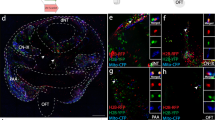Abstract
The nodose ganglion is the distal cranial ganglion of the vagus nerve which provides sensory innervation to the heart and other viscera. In this study, removal of the neuronal precursors which normally populate the right nodose ganglion was accomplished by ablating the right nodese placode in stage 9 chick embryos. Subsequent histological evaluation showed that in 54% of lesioned embryos surviving to day 6, the right ganglion was absent. Most embryos surviving to day 12, however, had identifiable right ganglia. In day 12 embryos, the right ganglion which developed was abnormal, with ganglion volume and ganglion cell diameter reduced by 50% and 20%, respectively, compared to control ganglia. To investigate the source of the neuron population in the regenerated ganglion, we combined nodose placode ablation with bilateral replacement of chick with quail “cardiac” neural crest (from mid-otic placode to somite 3). These cells normally provide only non-neuronal cells to the nodose ganglion, but produce neurons in other regions. At day 9, quail-derived neurons were identified in the right nodose ganglia of these chimeras, indicating that cardiac neural crest cells can generate neurons in the ganglion when placode-derived neurons are absent or reduced in number. On the other hand, we found that “sympathetic” neural crest (from somites 10 to 20) does not support ganglion development, suggesting that only neural crest cells normally present in the ganglion participate in reconstituting its neuronal population. Our previous work has shown that right nodose placode ablation produces abnormal cardiac function, which mimics a life-threatening human heart condition known as long QT syndrome. The present results suggest that the presence of neural crest-derived neurons in the developing right nodose ganglion may contribute to the functional abnormality in long QT syndrome.
Similar content being viewed by others
References
Bockman DE, Kirby ML (1984) Dependence of thymus development on derivatives of neural crest. Science 223:498–500
Christiansen JL, Stadt HA, Mulroy MJ, Kirby ML (1989) Electrocardiographic QT prolongation after ablation of the nodose placode in the chick embryo: a developmental model of the idiopathic long QT syndrome. Ped Res 26:11–15
d'Amico-Martel A (1982) Temporal patterns of neurogenesis in avian cranial sensory and autonomic ganglia. Am J Anat 163:351–372
d'Amico-Martel A, Noden DM (1983) Contributions of placodal and neural crest cells to avian cranial peripheral ganglia. Am J Anat 166:445–468
Fedde MR, Burger RE, Kitchell RL (1963) Localization of vagal afferents involved in the maintenance of normal avian respiration. Poultry Sci 42:1224–1236
Feulgen R, Rossenbeck H (1924) Mikroskopisch chemischer Nachweis einer Nucleinsäure vom Typus der Thymonucleinsäure und die darauf beruhende elektive Färbung von Zellkernen in mikroskopischen Präparaten. Hoppe-Seyler's Ztschr Physiol Chem 135:203–252
Hamburger V (1961) Experimental analysis of the dual origin of the trigeminal ganglion in the chick embryo. J Exp Zool 148:91–124
Hamburger V, Hamilton HL (1951) A series of normal stages in the development of the chick embryo. J Morphol 88:49–92
Hodges RD (1974) The histology of the fowl. Academic Press, London
Kessler JA (1985) Parasympathetic, sympathetic and sensory interactions in the iris: Nerve growth factor regulates cholinergic ciliary ganglion innervation in vivo. J Neurosci 5:2719–2725
Kessler JA, Bell WO, Black IB (1983) Interactions between sympathetic and sensory innervation of the iris. J Neurosci 3:1301–1307
Kirby ML (1989) Plasticity and predetermination of mesencephalic and trunk neural crest transplanted into the region of the cardiac neural crest. Dev Biol 134:402–412
Kirby ML, Stewart DE (1984) Adrenergic innervation of the developing chick heart. Neural crest ablations to produce sympathetically aneural hearts. Am J Anat 171:295–305
Kirby ML, Gale TF, Stewart DE (1983) Neural crest cells contribute to normal aorticopulmonary septation. Science 220:1059–1061.
Kirby ML, Turnage KL, Hays BM (1985) Characterization of conotruncal malformation following ablation of “cardiac” neural crest. Anat Rec 213:87–93
Kirby ML, Conrad DC, Stewart DE (1987) Increase in the cholinergic cardiac plexus in sympathetically aneural chick hearts. Cell Tissue Res 247:489–496
Mulroy MJ, Harrison TA (1994) Development study of the long QT with deafness syndrome in the chick embryo: cochlear pathology. Intl J Ped Otolaryngol 29:179–194
Mulroy MJ, Hotelling HB, Harrison TA (1990) Long QT and long QT with deafness syndrome: Beginning a neural analysis in an embryonic chick model. Ann NY Acad Sci 588:430–432
Narayanan CH (1970) Apparatus and current techniques in the preparation of avian embryos for microsurgery and for observing embryonic behavior. Bioscience 20:868–871
Noden DM (1978) Interactions directing the migration and cyto-differentiation of avian neural crest cells. In: Garrod DR (ed) The specificity of embryological interactions. Chapman and Hall, London, pp 3–49
Noden DM, Van der Water TR (1986) The developing ear: Tissue origins and interactions. In: Rubel RW et al. (eds) The biology of change in otolaryngology. Elsevier, Amsterdam, pp 15–46
Phillips MT, Kirby ML, forbes G (1987) Analysis of cranial neural crest distribution in the developing heart using quail-chick chimeras. Circ Res 60:27–30
Schwartz PJ, Bonazzi O, Locati E, Napolitano C, Sala S (1992) Pathogenesis and therapy of the idiopathic Long QT syndrome. In: Hashiba K, Moss AJ, Schwartz PJ (eds) AT prolongation and ventricular arrhythmias. Ann NY Acad Sci 644:112–141
Author information
Authors and Affiliations
Additional information
This work was supported by grant PO1 HL 36059
Rights and permissions
About this article
Cite this article
Harrison, T.A., Stadt, H.A., Kumiski, D. et al. Compensatory responses and development of the nodose ganglion following ablation of placodal precursors in the embryonic chick (Gallus domesticus). Cell Tissue Res. 281, 379–385 (1995). https://doi.org/10.1007/BF00583407
Received:
Accepted:
Issue Date:
DOI: https://doi.org/10.1007/BF00583407




